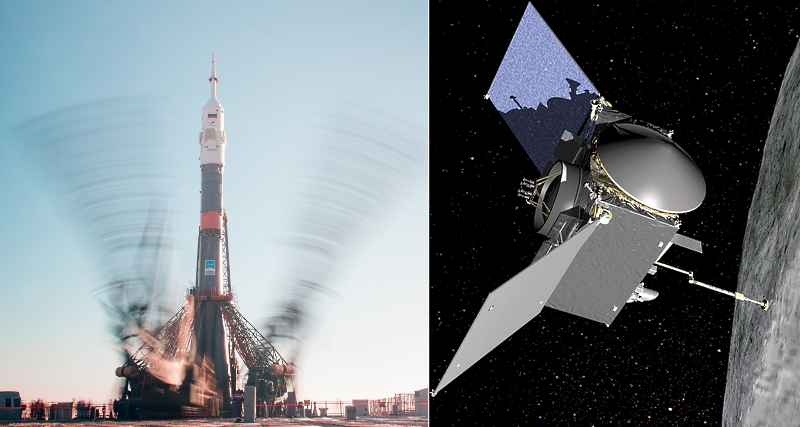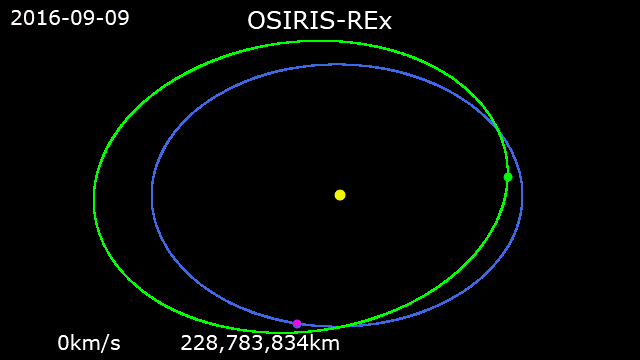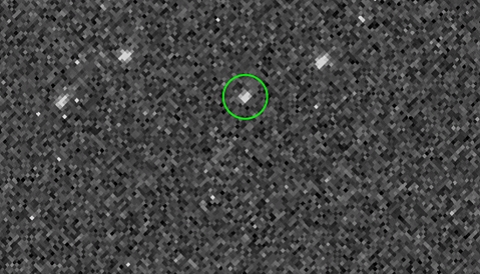Start to the ISS and braking at the asteroid
Immediately, two rather important space events will occur today: for the first time after the Soyuz MS-10 accident, a manned mission, the Soyuz MS-11, will go to the ISS, and the OSIRIS-REx will arrive at the Bennu asteroid.

A rocket with the Soyuz MS-11 and OSIRIS-REx spacecraft, NASA images
Returning to flying after an incident always causes increased attention, despite the fact that it is one of the safest options. In fact, the cause of the accident must be eliminated, and people throughout the production chain work with increased attention. But a purely psychologically fresh reminder of the danger of space flight makes one worry about the crew more than usual. Therefore, it is not surprising that at a press conference before the start of the Union of the Union MS-11, journalists asked whether the astronauts were nervous.
It is curious that, despite the transfer of the launch from December 20 to the third, the Soyuz will approach the ISS in a short, six-hour scheme. Typically, such force majeure, on the contrary, lead to a two-day approach scheme . I am glad that the investigation took so little time, but it was lucky, so to speak, that the cause of the accident turned out to be easily detected and removable. Other types of accidents might cause a longer break in flights. And, finally, it is worth noting that as early as December 11, a spacewalk is planned, which will have to provide additional information in the case of it is unclear by whom, when, how and why of the drilled hole in the Union MS-09.
The launch of the ship is scheduled for 14:31 Moscow time on December 3, docking with the ISS - 20:36 Moscow time. Starting with Soyuz MS-09, they show videos from onboard cameras on a rocket, so it should be interesting. Search the Roscosmos broadcast on the agency’s social networks, besides, you should stream NASA-TV on YouTube.
In the evening, around 19:15 Moscow time, the OSIRIS-REx apparatus will arrive at the Bennu asteroid (101955 Bennu). It started on the night of September 9, 2016 and, having worked for the target until spring 2021, would return the asteroid samples for Earth in the fall of 2023. By space, these are short terms - Rosetta flew to Churyumov-Gerasimenko’s comet for ten years. Asteroid Bennu has a much closer to Earth orbit (in the 22nd century there are even chances that it will collide with the Earth), so it is much easier to reach it. OSIRIS-Rex needed only one long start of engines with a change in speed of 431 m / s and one gravitational maneuver near the Earth.

Animation of Wikimedia Commons according to NASA
The first photo from a distance of 2 million kilometers was taken in August, and last Sunday only 30 kilometers separated OSIRIS-REx and Bennu.

NASA Photos
But this animation is made from photos from November 2. The rotation is accelerated, Bennu makes one revolution in 4.3 hours.

In general, OSIRIS-REx for the most part has already arrived - the main maneuvers were performed on October 1 and 15 and changed the speed of the device in the amount of 486 m / s. Further the probe already practically "creeped". By two inclusions of the engines on October 29 and November 5, the speed relative to the asteroid was reduced from 5.2 to 0.1 m / s, and on November 13 the maneuver reduced it from 0.14 to 0.04 m / s. On November 30, the final correction took place, and on December 3, the device will approach to a distance of 20 km and go into orbit relative to the asteroid. The main task is to take a sample with a special manipulator, but before that OSIRIS-REx will fly around for a long time and choose a place.

Animation of Wikimedia Commons according to NASA
An asteroid is so small and light that even random disturbing effects can make it difficult to work in its orbit. For example, in 2017, a microscopic disturbing thrust was recorded on the probe. It turned out that from the illuminated side of the apparatus, the moisture that had been accidentally deposited before the start evaporates. I had to perform a long program to get rid of it - the probe alternately turned to the Sun with different sides and warmed them.

But this photo is an important element of the preparation of the probe for work. Since October, we have tested the TAGSAM manipulator, with which the probe will collect asteroid samples — it has been deployed, its mobility has been checked, photographed, and the apparatus has been screwed up before and after resetting the 1.2-kg cover. The moments measured by these maneuvers will allow weighing the collected samples - the greater their mass, the harder it will be to twist OSIRIS-REx.
If everything goes according to plan, the probe will take a sample of the asteroid in mid-2020 ...
and, returning them to a special capsule to Earth in 2023, will be the first American probe to deliver asteroid material to Earth. You can read about similar missions that brought samples of other celestial bodies here .
UPD1: "Soyuz" in orbit, everything is fine, closer to the ISS according to plan.
UPD2: Astronaut Alexander Gerst published on his Twitter view of the launch of the "Union" with the ISS
UPD3: Soyuz docked, OSIRIS-REx arrived at the orbit of the asteroid Bennu, you can breathe out.

A rocket with the Soyuz MS-11 and OSIRIS-REx spacecraft, NASA images
"Union MS-11"
Returning to flying after an incident always causes increased attention, despite the fact that it is one of the safest options. In fact, the cause of the accident must be eliminated, and people throughout the production chain work with increased attention. But a purely psychologically fresh reminder of the danger of space flight makes one worry about the crew more than usual. Therefore, it is not surprising that at a press conference before the start of the Union of the Union MS-11, journalists asked whether the astronauts were nervous.
Risk is a component of our profession. We go through many training sessions where we work on various abnormal situations, so we understand that we can encounter them in real space flight, but we also understand that people who assemble a ship and a rocket try to do this as accurately as possible, following as much technical documentation as possible. <...> We absolutely trust them. We are both psychologically and technically ready to start and any situations that, God forbid, will occur on boardThe cosmonauts' confidence has a practical basis - after the accident of the Soyuz MS-10, three rockets with the same level separation system successfully launched: on October 25, the Soyuz-2.1b launch vehicle with the Kosmos-2528 satellite flew, on November 3 - Soyuz-2.1b ”with“ GLONASS-M ”and on November 16 is a completely uniform emergency“ Soyuz-FG ”with“ Progress MS-10 ”. Let me remind you that the cause of the accident of the Union MS-10 was the bent sensor of the side unit compartment (first stage). To date, the investigation has not yet been completed on how exactly it was bent in the process of assembling the launch vehicle, and, according to the latest news , so far no one from the staff of the assembly shop has been removed from work.
Oleg Kononenko
I believe that when such situations occur, you need to ask three main questions: what happened, why it happened and how to prevent the situation from recurring. We are confident that our flight will be successful, because in the interval from the accident that occurred and to this day there have been several successful launches
Ann Maclaine
')
At that moment when it all happened (the accident on October 11), I was lucky that I was here, next to the crew, who felt great after a bad start. Everything went well, and thanks to the fact that smart people who created the rocket and the emergency rescue system and the ship work here, we managed to avoid the accident (the ship) and I was fortunate enough to witness this situation. I am sure that in our case this will not happen and everything will go smoothly.
David Saint-Jacques
It is curious that, despite the transfer of the launch from December 20 to the third, the Soyuz will approach the ISS in a short, six-hour scheme. Typically, such force majeure, on the contrary, lead to a two-day approach scheme . I am glad that the investigation took so little time, but it was lucky, so to speak, that the cause of the accident turned out to be easily detected and removable. Other types of accidents might cause a longer break in flights. And, finally, it is worth noting that as early as December 11, a spacewalk is planned, which will have to provide additional information in the case of it is unclear by whom, when, how and why of the drilled hole in the Union MS-09.
The launch of the ship is scheduled for 14:31 Moscow time on December 3, docking with the ISS - 20:36 Moscow time. Starting with Soyuz MS-09, they show videos from onboard cameras on a rocket, so it should be interesting. Search the Roscosmos broadcast on the agency’s social networks, besides, you should stream NASA-TV on YouTube.
OSIRIS-REx
In the evening, around 19:15 Moscow time, the OSIRIS-REx apparatus will arrive at the Bennu asteroid (101955 Bennu). It started on the night of September 9, 2016 and, having worked for the target until spring 2021, would return the asteroid samples for Earth in the fall of 2023. By space, these are short terms - Rosetta flew to Churyumov-Gerasimenko’s comet for ten years. Asteroid Bennu has a much closer to Earth orbit (in the 22nd century there are even chances that it will collide with the Earth), so it is much easier to reach it. OSIRIS-Rex needed only one long start of engines with a change in speed of 431 m / s and one gravitational maneuver near the Earth.

Animation of Wikimedia Commons according to NASA
The first photo from a distance of 2 million kilometers was taken in August, and last Sunday only 30 kilometers separated OSIRIS-REx and Bennu.

NASA Photos
But this animation is made from photos from November 2. The rotation is accelerated, Bennu makes one revolution in 4.3 hours.

In general, OSIRIS-REx for the most part has already arrived - the main maneuvers were performed on October 1 and 15 and changed the speed of the device in the amount of 486 m / s. Further the probe already practically "creeped". By two inclusions of the engines on October 29 and November 5, the speed relative to the asteroid was reduced from 5.2 to 0.1 m / s, and on November 13 the maneuver reduced it from 0.14 to 0.04 m / s. On November 30, the final correction took place, and on December 3, the device will approach to a distance of 20 km and go into orbit relative to the asteroid. The main task is to take a sample with a special manipulator, but before that OSIRIS-REx will fly around for a long time and choose a place.

Animation of Wikimedia Commons according to NASA
An asteroid is so small and light that even random disturbing effects can make it difficult to work in its orbit. For example, in 2017, a microscopic disturbing thrust was recorded on the probe. It turned out that from the illuminated side of the apparatus, the moisture that had been accidentally deposited before the start evaporates. I had to perform a long program to get rid of it - the probe alternately turned to the Sun with different sides and warmed them.

But this photo is an important element of the preparation of the probe for work. Since October, we have tested the TAGSAM manipulator, with which the probe will collect asteroid samples — it has been deployed, its mobility has been checked, photographed, and the apparatus has been screwed up before and after resetting the 1.2-kg cover. The moments measured by these maneuvers will allow weighing the collected samples - the greater their mass, the harder it will be to twist OSIRIS-REx.
If everything goes according to plan, the probe will take a sample of the asteroid in mid-2020 ...
and, returning them to a special capsule to Earth in 2023, will be the first American probe to deliver asteroid material to Earth. You can read about similar missions that brought samples of other celestial bodies here .
UPD1: "Soyuz" in orbit, everything is fine, closer to the ISS according to plan.
UPD2: Astronaut Alexander Gerst published on his Twitter view of the launch of the "Union" with the ISS
UPD3: Soyuz docked, OSIRIS-REx arrived at the orbit of the asteroid Bennu, you can breathe out.
Source: https://habr.com/ru/post/431820/
All Articles